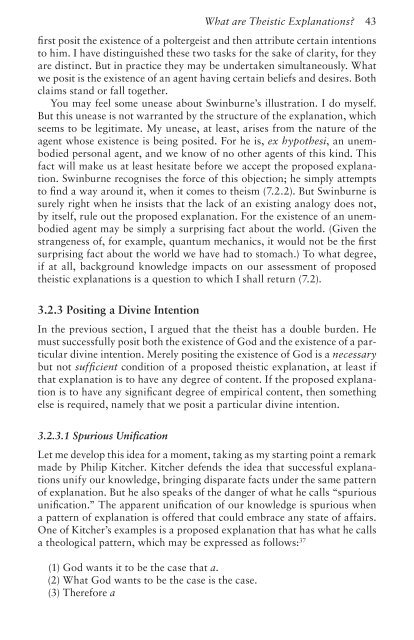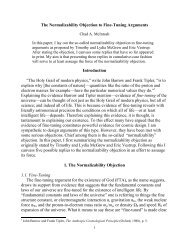Theism and Explanation - Appeared-to-Blogly
Theism and Explanation - Appeared-to-Blogly
Theism and Explanation - Appeared-to-Blogly
Create successful ePaper yourself
Turn your PDF publications into a flip-book with our unique Google optimized e-Paper software.
What are Theistic <strong>Explanation</strong>s? 43<br />
fi rst posit the existence of a poltergeist <strong>and</strong> then attribute certain intentions<br />
<strong>to</strong> him. I have distinguished these two tasks for the sake of clarity, for they<br />
are distinct. But in practice they may be undertaken simultaneously. What<br />
we posit is the existence of an agent having certain beliefs <strong>and</strong> desires. Both<br />
claims st<strong>and</strong> or fall <strong>to</strong>gether.<br />
You may feel some unease about Swinburne’s illustration. I do myself.<br />
But this unease is not warranted by the structure of the explanation, which<br />
seems <strong>to</strong> be legitimate. My unease, at least, arises from the nature of the<br />
agent whose existence is being posited. For he is, ex hypothesi, an unembodied<br />
personal agent, <strong>and</strong> we know of no other agents of this kind. This<br />
fact will make us at least hesitate before we accept the proposed explanation.<br />
Swinburne recognises the force of this objection; he simply attempts<br />
<strong>to</strong> fi nd a way around it, when it comes <strong>to</strong> theism (7.2.2). But Swinburne is<br />
surely right when he insists that the lack of an existing analogy does not,<br />
by itself, rule out the proposed explanation. For the existence of an unembodied<br />
agent may be simply a surprising fact about the world. (Given the<br />
strangeness of, for example, quantum mechanics, it would not be the fi rst<br />
surprising fact about the world we have had <strong>to</strong> s<strong>to</strong>mach.) To what degree,<br />
if at all, background knowledge impacts on our assessment of proposed<br />
theistic explanations is a question <strong>to</strong> which I shall return (7.2).<br />
3.2.3 Positing a Divine Intention<br />
In the previous section, I argued that the theist has a double burden. He<br />
must successfully posit both the existence of God <strong>and</strong> the existence of a particular<br />
divine intention. Merely positing the existence of God is a necessary<br />
but not suffi cient condition of a proposed theistic explanation, at least if<br />
that explanation is <strong>to</strong> have any degree of content. If the proposed explanation<br />
is <strong>to</strong> have any signifi cant degree of empirical content, then something<br />
else is required, namely that we posit a particular divine intention.<br />
3.2.3.1 Spurious Unifi cation<br />
Let me develop this idea for a moment, taking as my starting point a remark<br />
made by Philip Kitcher. Kitcher defends the idea that successful explanations<br />
unify our knowledge, bringing disparate facts under the same pattern<br />
of explanation. But he also speaks of the danger of what he calls “spurious<br />
unifi cation.” The apparent unifi cation of our knowledge is spurious when<br />
a pattern of explanation is offered that could embrace any state of affairs.<br />
One of Kitcher’s examples is a proposed explanation that has what he calls<br />
a theological pattern, which may be expressed as follows: 37<br />
(1) God wants it <strong>to</strong> be the case that a.<br />
(2) What God wants <strong>to</strong> be the case is the case.<br />
(3) Therefore a



